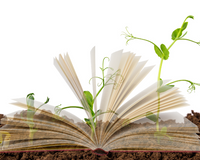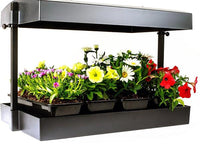Every indoor and outdoor grower wants to grow big buds and enjoy a higher yield. There are things you can do during every stage of plant growth to achieve this.
Here, we compile some of the best tips for indoor growers. Many of these techniques work well for outdoor crops, too.
Yes, it all begins with seed selection. Some strains produce bigger yields and/or bigger flowers. When choosing seeds, make sure the breeder has a reputation for great seeds that produce big-ass buds for indoor grows. You may get some good leads through Instagram.
Note: We can’t condone breaking any laws, and mail order across state lines is illegal.
If cannabis is legal where you live, you can buy seeds at a dispensary, but do your homework before buying.
Optimize Light Exposure with Low-Stress Training (LST)

If you train your plants properly using LST, you won’t just enjoy bigger buds, but more of them as well! The buds will also grow more evenly. Without training, the top buds will likely grow a lot faster than the lower ones.
There are bonus benefits, too. LST is great for spaces with low ceilings because it gives you more control over the height and shape of each plant. It can also prevent the plants from getting too close to the grow lights.
When using this method, be gentle and don’t break the branches. Start the process when plants are young and less brittle.
Warning: LST may lengthen the vegetative stage by roughly two weeks.
Use Proper Pruning Techniques for Big Buds
This is a nuanced topic, so advice will vary by source.
Pruning focuses energy on the most important parts of the plant, and this means bigger buds.
At a minimum, you want to clip the shoots near the bottoms of the plants during the vegetative stage, particularly the ones receiving less light. If any branches or leaves begin to die or get damaged, clip them. Doing this during the vegetative stage gives plants time to recover.
Some growers will begin pruning during the late vegetative or early to mid-flowering stages. As you get close to, or into, the flowering period, make sure you know what you’re doing. Recovery becomes more delicate as the plants age. Contact us if you have any questions.
Circulate & Replenish the Air

Use fans for air circulation. Oscillating fans move the air around the room. The leaves of the plants should wiggle, but don’t blast them with heavy winds.
Use an exhaust fan to push air out of the room and an intake fan replace the air. Air should leave the room at a higher rate than incoming air to ensure good CO2 levels. Use a carbon filter to prevent contamination so you plants can focusing on making big buds.
The Grow1 In-line Duct Fan can be used for filtering, intake, and exhaust. Airbox Jr. filters eliminate 98% of all insects, molds, mildews, spores, pollen, dust, dander, and other airborne particles from your incoming air.
Maintain Optimal Temperatures
Your plants will enjoy a range of 70-80 degrees Fahrenheit (21-26.5 Celsius) while flowering. Don’t go over 82F when they’re flowering because this will slow bud development and cause the terpenes to evaporate. Aim for the upper 70’s.
Let your plants cool when the lights aren’t on, as this will help them produce better trichomes (hairs).
During the vegetative stage, 68-77F (20-25C) is ideal.
Keep the Humidity Low During Flowering to Prevent Pests
Air that is too moist or too dry can kill the plants or ruin them. When it’s too high, it can invite unwanted company during the flowering stage. 50% relative humidity is good, or anywhere in the 40%-60% range. You can use a dehumidifier, humidifier, and AC to control humidity.
You can also use the budget-conscious LTL Element 1 Environmental Controller to take care of temperature and humidity with one device.
When the plants are young, they prefer higher humidity. 70% or higher is great during the early portions of the vegetative stage. You can lower it near the end of that stage.
Larger pots mean bigger roots. Bigger roots mean bigger flowers.
Control Your Lighting

During the vegetative stage, your plants need about 18-20 “sunlight” hours. The flowering stage requires 12.
One generic “rule of thumb” is to give your plants 35-50 watts per square foot. This could vary according to the lights you use and other factors.
Use HID or LED Lights If Possible
A lot of growers use metal halide lights for vegetating plants and high-pressure sodium lamps for flowering to optimize bud growth. Both belong to the high-intensity discharge (HID) light category. One drawback is that they may overheat your plants if you’re not careful.
If you can afford LED lights, buy some to prevent frying your plants. LED’s conserve energy and provide full spectrum light. Lighting systems from the SolarSystem Series by California Lightworks can save you up to 50% in energy costs and prevent the hassle of changing bulbs.
Optimize pH
Acidity helps determine how much of each nutrient the plant absorbs through the roots. Normally, a pH of 6 is great for nutrient absorption. However, your pH needs may differ depending on whether you use bottled nutrient mixes or organic ones.

To get the most out of your crops, you need to learn about nutrients and what each one does at every stage. Timing is important.
Calcium nitrate adds biomass to your plants.
Nitrogen speeds growth, makes the plants more dense, and decreases foliage for better surface area light coverage. That means greater yields compared to plant size. Nitrogen makes branches stronger, too.
Holding back nitrogen at certain stages can bring the buds closer together because the internodes are smaller. Keep a batch of NPK Raw Nitrogen handy https://growsupplyshop.com/products/npk-industriesraw-solublesraw-nitrogen, but make sure you know when to use it. Also keep in mind that it will lower your soil’s pH.
Phosphorus is an important one for bud size, too. Add some during the flowering stage. When feeding with phosphorus, scale back the nitrogen. Potassium can support bud size, too, while improving the plant’s immune system. Low phosphorus is a major limiting factor during any growing stage, so it’s good to have around. NPK Raw Phosphorus https://growsupplyshop.com/products/npk-industriesraw-solublesraw-phosphorus can become a good friend during this stage.
Talk to a Growing Expert for Free
Message us with any questions about your grow. We provide free guidance, whether you’re stuck in a major problem or you just want the biggest possible buds.
(800) 587-6207 - Text Us!
#GetYourGrowOn









